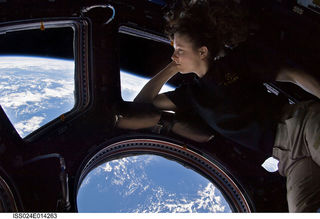Relationships
The Longest-Distance Relationship
How astronaut Tracy Caldwell Dyson’s space missions influenced her worldview.
Posted September 25, 2018

A new experience or setting often jolts us out of familiarity, leading us to reflect more deeply or revise our worldview. As new surroundings go, outer space may offer one of the starkest possible changes. Astronaut Tracy Caldwell Dyson has experienced that transition firsthand. A chemist by training, Caldwell Dyson was selected to be a NASA astronaut at age 29. Over the past two decades, she has completed two space flights spanning more than 188 days. The time beyond Earth’s atmosphere has shaped Caldwell Dyson’s perspective on values ranging from sustainability and teamwork to beauty and marriage.
When did you decide that you wanted to be an astronaut?
I didn’t know what I wanted to be when I grew up, so when I was 16, my parents encouraged me to make a list of all the things I enjoyed doing. I wrote down things like “do science,” “be athletic,” and “work with tools.” At the time, NASA was in the news and everyone was really excited about an upcoming mission. It happened to be the one with the first teacher to go into space, Christa McAuliffe. That was the first time I really thought about who astronauts were and what they were doing. I found out that they were building an international space station and needed astronauts on board who knew science and used tools. I looked at what NASA was looking for in astronauts and the list I wrote for my parents, and I saw a big connection there and got really excited.
How did it feel when you were selected?
Oh, it was almost indescribable. I hyperventilated when the chief of the office called to tell me. When I got the call, that “hey we’d like you to come to Houston,” I didn’t know how to handle it. Once I got my breath, the chief said, “Why don’t I just call you back, Tracy, and we can talk details after you have a few minutes to collect yourself.” I hung up the phone, and I went running down the hallway screaming, “I made it! I made it!” I went to the chemistry laboratory at UC Irvine where the rest of my research group was, and I shared the news with them. We all jumped up and down like kindergarteners on party day. Then I realized he was calling me back. He said, “Tracy we’re excited to have you and we’ll send more information, but in the meantime, we have a press release going out and until then we’d like you to limit the news to your immediate family. I didn’t say a word. He hears the silence and says, “I take it it’s a little late for that?”
Can you describe the process of launching into space for the first time?
For the eight and a half minutes of ascent, it was part hard work and part elation. We each had a specific role, so I was focused on that, and one of the most stressful things I had to do—besides make it to space alive—was to be the first person to unstrap from my seat once we got to orbit and position myself at a window to film our external tank falling away from our rocket. This was all in the wake of the Columbia accident, so we had many countermeasures in place to protect ourselves. One of those things was filming this external tank as it fell back to earth. I had this significant job, and if I didn’t get out of my seat in time, or if I felt sick and started puking, I would really screw it up. So that whole eight minutes seemed like a cross between “I cannot wait to get there” and “Keep your eyes on the road, Tracy.”
As we were going uphill, it felt like this gigantic gorilla was sitting on my chest, because the G-forces are building, and you have to practice breathing in a way that allows you to withstand the forces. For the first two minutes, you’re riding up on solid rocket boosters that are very powerful, and it causes the spaceship to shake a lot, to the extent that looking at a screen is fuzzy and it’s difficult to see all the digits you’re trying to monitor. But once those rocket boosters extinguish and fall away from the vehicle, the three main engines on the shuttle kick in, and it was the smoothest, most powerful ride I’ll have in my entire life.
It was a moment of pride, too, knowing that the spaceship is American-made, and one of the most spectacular, high-performance masterpieces of our country’s history. It was such a joy knowing how many tens of thousands of people and their terrific skills went into this moment. I was feeling that I was the recipient of great joy.
What was it like to view Earth after you had reached the International Space Station?
It was the end of a really long day, and our commander asked mission control to turn off all of external lights on the space station. Otherwise it’s like you’re in a big city and light pollution masks the stars and everything. Then for 90 glorious minutes, we just drooled at the window. You’re so far above the surface of the earth that you see the curvature, but you’re close enough to see significant detail like mountain ranges and shorelines. Because of the position of the sun, the motion of the earth, and our velocity relative to the earth, things are constantly changing. Shadows are shifting, and the color of the terrain and water are changing. It goes from this pearlescent creamy yellow to these intense reds and blues and greens. It’s just this amazing symphony of sights. It goes so fast, so as soon as your eyes settle on something beautiful, you have to let go of it, because you’re passing it by.
Once you’ve taken that all in, you look up at the structure you’re attached to, and the space station itself becomes a marvel. When you think about all the countries that have put in work on this space station—and it was all assembled in space—it’s an amazing thing. You’re watching solar rays turn, radiators flip around, boxes that look like they’re not doing anything, but you know the machinery inside is doing really important things. You think of the immense number of people in space with you right now, because their hands have touched this thing. You look at the blackness of space and the stars. And you realize, “I’m in outer space. I’m someplace where few have gone.”
Did you experience the overview effect, a shift in awareness due to viewing the Earth from space?
Other astronauts have made this very comment, and it sounds kind of cliché, but you don’t see borders up there. You see the difference between land and water, but you don’t see borders between countries, and you don’t see why anybody should take ownership of any part of it. You wonder if everybody could come up and see this, how protective they might feel then of our planet—this magnificent blue plump thing in the midst of this blackness—realizing just how precious it is. You have a great appreciation for it, because it has sustained you. You’re floating comfortably, and it’s almost unreal. Then, all of a sudden, ground calls you and says they need you to get a wrench out and turn a bolt and you say, “Oh yes, I’m working up here,” and you get back to that.
How did that experience shape your life on Earth?
I’ve always been someone who recycles and tries to be good to the environment, but I think it strengthens me in that regard. It’s trying to be part of a larger effort, because I’ve seen it from a different vantage point and know that my efforts alone are not going to be enough to keep this Earth from imploding if we continue to exploit it and use its resources.
What’s the biggest challenge you’ve faced as an astronaut?
Relationships, all across the board. You don’t pick your crew—you get picked on a crew. It’s a real blessing when you discover how to work with someone. I don’t mean that to sound trite, but there’s a certain amount of pride we all have in our abilities and our desire to do great work. Sometimes pride and perceptions get in the way of seeing who somebody really is and what they’re trying to do. Breaking through that barrier takes experience, people giving you feedback, and learning to accept that feedback.
How did your personal relationships change before and after your missions?
Your family makes tremendous sacrifices. There are great joys and privileges with what I do, and when I get to share that with my family, it’s rewarding. But oftentimes, it’s not safe or appropriate to include them, so they become outsiders, even though they’re your closest people. I was single when I went on my shuttle flight, though I was dating the man I ultimately married, so I was very focused on my parents. Without their support, it would have been a lonely trip. The way I regard my parents is even stronger now because of the unconditional love and support they’ve given me. I’m glad I realized the time and energy they sacrificed, because I know when it comes my turn to do that for someone I love, I’ve got a great example to follow.
Another unique situation was with my husband. My husband was active duty military. While I was training for my second space flight, his squadron was transitioning from a base in California to a base in Atsugi, Japan. We were separated geographically by a lot of miles, and we weren’t able to talk to one another frequently. He was on a ship and I was traveling around the world. This was all leading up to my space mission where I was launching from another country. There was a lot of stress with that, like thinking about his safety, when we were ever going to be together, and the limited communication we had. Even when we did get to talk it wasn’t private. It was always in front of other people on the loudspeaker.
We learned so much about letting go and trusting each other. It really changed my understanding of what marriage was. I never really saw myself in a marriage because I didn’t know that I was willing to give up things I could keep for myself, but sure enough, my husband is that guy. We didn’t understand this at the time, but it was a blessing in learning to maintain a relationship through adversity.
What is the most logistically challenging task to perform in space?
This isn’t glamorous, but stowage is a real big factor in space. When you pack your suitcase on Earth, most people will lay out their clothes. Everything just stays on the bed, waiting for you to pick it up. They would pack things super tight on the ground, trying to fit as much as they could in the bag. Then it gets to space, and we’d open it up and there was actually no way to put things back in this bag because it’s like a trunk of butterflies! Objects want to be out and free, and you can’t harness them like you do on Earth.
You learned sign language and created videos using sign language while in space. What inspired that?
The deaf community is near and dear to my heart. When I was in high school, I encountered two people that used sign language: my friend on the track team who was deaf, and my best friend who used sign language to communicate with her aunt. When I went to graduate school, a classmate asked me to tutor his student who was deaf. This young lady was bright and really wanted to learn, but she was at such a disadvantage because she was at a hearing university. I went to class with her one night. She had to take her own notes, watch the professor, watch the slides, watch the interpreter, and then look at her own notes. This was all in a near-dark auditorium, and her eyes had to be in four different places! At the time, we didn’t have texting. When she needed to call me to coordinate or ask questions, she had to talk to me through a relay operator. A conversation that would normally take five minutes took 30.
That experience made me appreciate people in the deaf community who work their tails off to do the same things others do. I was so energized by it that I wanted to do something. NASA got involved, and I got in touch with the Texas School for the Deaf and then gave a tour of the space station in sign language. That was a really endearing part of my mission. I wanted to bring the space station to them and give the community excitement and inspiration that there’s a place here for you. I don’t know where that is currently, since astronauts need to be able to hear to do the job, but there are so many other things the deaf community can do until we come up with a way to bring them into space.




